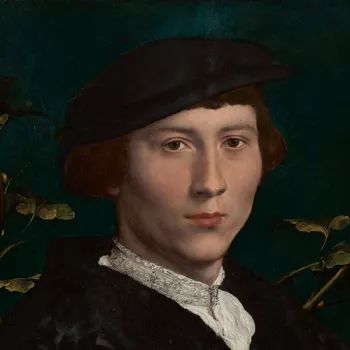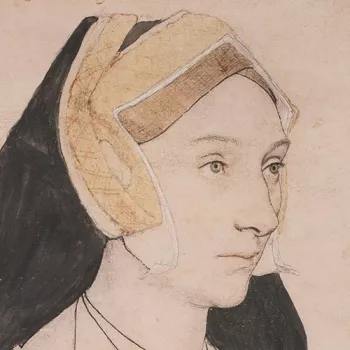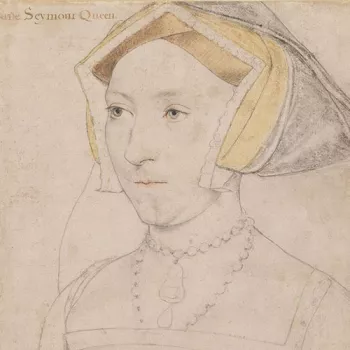
Hans Holbein
Portrait artist at Henry VIII's Court.
Reading time 5 minutes
The five Tudor monarchs who ruled from 1485 until 1603 oversaw one of the most turbulent periods in English history. Henry VIII, the second Tudor king, employed artists from across Europe to establish his power and magnificence at home and abroad. Among these artists was the brilliant painter Hans Holbein the Younger, who travelled to England in search of work.
Over the next twenty-seven years, Holbein established himself as one of the leading artists in England, his remarkable portraits recording the likenesses of the men and women of the Tudor court, among them Sir Thomas More and Anne Boleyn. Holbein’s skill saw him appointed King’s Painter to Henry VIII, tasked with painting the King, his wives and his children.
What was Holbein’s path to such success?
Hans Holbein the artist
Hans Holbein was born in Augsburg in Germany. From at least 1515 until 1526 he worked in the Swiss city of Basel, where he found success painting altarpieces and house facades, designing book illustrations and stained glass, and making portraits of the city’s elite. In 1526, he left Basel to look for work in England.
Holbein’s journey from Basel to London was partly driven by necessity: religious reform had led to a reduction in the number of commissions for paintings and designs, and painters in the Swiss city were struggling to make ends meet. But Holbein’s decision to travel to London was also driven by ambition.
Henry VIII, England’s King since 1509, was providing employment to artists from across Europe to compete with his European rivals. Here Holbein might secure royal patronage, which would bring reputational success and, potentially, a stable income in the form of a regular salary.
Sir Thomas More
Holbein’s first contact in England was Sir Thomas More, Chancellor of the Duchy of Lancaster, who regularly dined with Henry VIII and his first wife Catherine of Aragon. More gave Holbein two early commissions for paintings, among them a portrait of More in his collar of Esses, a livery collar worn by the most senior members of the court.
He also introduced Holbein to friends such as Henry Guildford, the Comptroller of the Royal Household. Guildford provided Holbein with his first royal commission, as one of a group of artists making temporary decorations at Greenwich Palace.
These decorations were for a meeting between Henry VIII and French diplomats to celebrate a peace settlement between England and France. At Greenwich, Holbein painted a map on the ceiling and a depiction on the back of an arch of Henry VIII’s victory over French forces at the siege of Thérouanne in 1513. Unfortunately, neither of these works survives.
Success at court
Holbein returned to Switzerland, where he had a family, in 1528, perhaps worried about losing his Basel citizenship. But he returned to London in 1532, and began to find wider success in England.
Among his first patrons on his return were a group of German merchants based in London who commissioned paintings for their communal hall and individual portraits from Holbein. See a painting of one of these German merchants.
They also asked him to design a triumphal arch to mark the Coronation of Anne Boleyn in 1533. English courtiers also commissioned portraits from Holbein. Among them were Thomas Wyatt, the ambassador, poet and courtier, and Richard Southwell, an ambitious landowner from Norfolk who was rapidly gaining influence at court.
Henry VIII’s painter
It may have been Holbein’s work for figures such as Wyatt and Southwell who brought him to the attention of the King. Or perhaps it was Anne Boleyn, Henry’s second wife, who encouraged her husband to take notice of the German painter.
Holbein made a portrait of Anne sometime between 1532 and 1536, and although the finished work does not survive, a drawing in the Royal Collection shows the Queen in informal dress, wearing a nightgown and simple cap. However he came to Henry VIII’s notice, Holbein was appointed King’s Painter by September 1536.
This role brought royal commissions, gifts of livery (official uniform) and a regular salary of £30 a year. However, Holbein was not the only King’s Painter, and his salary was not as high as his contemporaries. The minitaure painter Lucas Horenbout was paid £33 6s a year and the Italian engineer and painter Girolamo da Treviso received £100 a year.
The wives of Henry VIII
Holbein was clearly valued by Henry, who provided him with a number of commissions for portraits. Among these was a mural at Whitehall Palace (near Westminster Abbey) destroyed by fire in 1698 but known through a copy made shortly before its destruction. This showed Henry VIII, his parents and his third wife Jane Seymour at life size, and was said to shock those who saw it with its lifelike appearance.
Holbein also made single portraits of Jane Seymour: a drawing in the Royal Collection bears a number of horizontal lines which were used to define different lengths of portrait. Holbein painted a panel painting and a miniature of Anne of Cleves, Henry’s fourth wife, and may also have made a miniature of Katherine Howard, Henry’s fifth wife, although this identification is impossible to confirm.
Alongside portraits, Holbein worked as a designer for the royal family, designing metalwork, jewellery and arms and armour. On New Year’s Day 1539, Holbein presented Henry VIII with a painted portrait of the one-year-old Prince Edward, the King’s heir. This seems to have been a gift from the artist to his patron rather than a royal commission.
The portrait is in the National Gallery of Art in Washington, and a preparatory drawing for the painting is in the Royal Collection. See the drawing of Prince Edward.
Holbein’s legacy
On Holbein’s death in 1543, a selection of his portrait drawings passed to the King. They appear to have been available to artists who worked for the later Tudor monarchs, among them Elizabeth I.
Although we do not know how these works arrived in royal hands, they were clearly treasured as the work of an artist who had come to England in search of success and had found it as the image maker of the Tudor court.










